Menus
- Hero worship
- What a huge motorcycle!
- Material at its best
- Amazingly close to a current RSV4
- Enough with the theory, the pit light turns green
- The Kawasaki ZXR 750 RR is super stable on the brakes
- 20 years? You don’t notice that in Paul
- Further information on the Schmid / Stuckle dream team
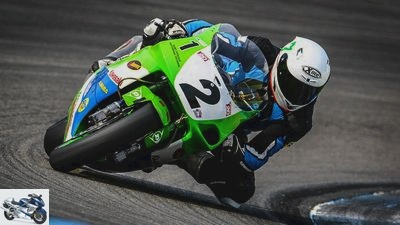
Racepixx.de

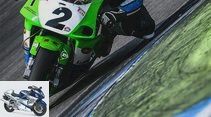
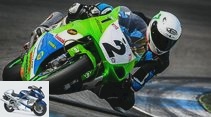
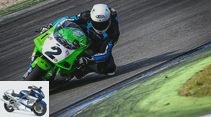
21st photos
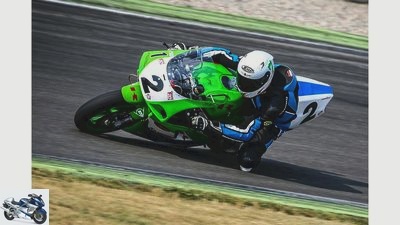
Rene Unger / Racepixx.de
1/21
Uwe Seitz fulfills a 20-year-old wish: with the Kawasaki ZXR 750 RR from Jochen Schmid on the slopes.
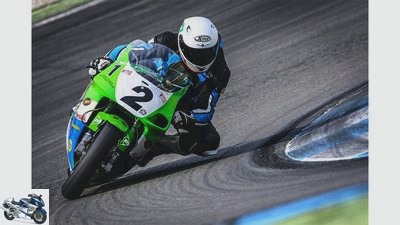
Rene Unger / Racepixx.de
2/21
Kawasaki ZXR 750 RR.
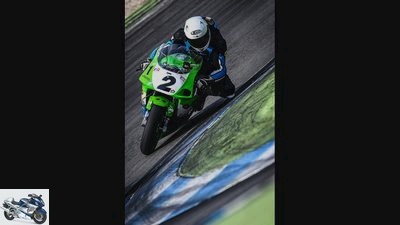
Rene Unger / Racepixx.de
3/21
Kawasaki ZXR 750 RR.

Rene Unger / Racepixx.de
4/21
Kawasaki ZXR 750 RR.
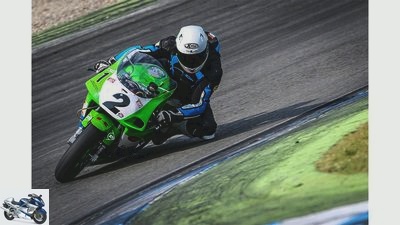
Rene Unger / Racepixx.de
5/21
Kawasaki ZXR 750 RR.
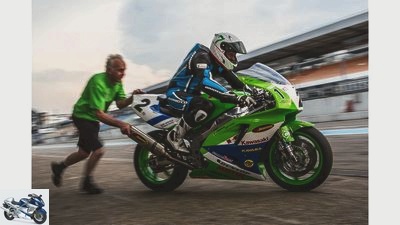
Rene Unger / Racepixx.de
6/21
… The starter also fell victim to the combat weight of 157 kilos (excluding fuel). What an honor to be pushed by Kurt Stuckle!
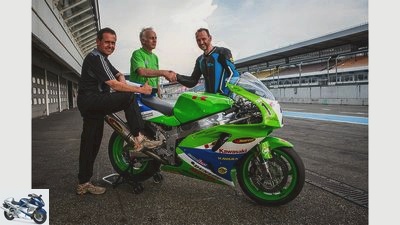
Rene Unger / Racepixx.de
7/21
Full of anticipation, because I’m about to get on the bike, however …
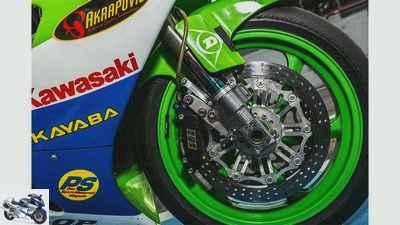
Rene Unger / Racepixx.de
8/21
PVM brake on exquisite GP fork from Kayaba – a great combination.
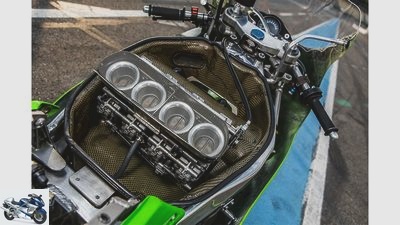
Rene Unger / Racepixx.de
9/21
The gigantic airbox with the four Keihin carburetors gives Paul a lot of legs.

Rene Unger / Racepixx.de
10/21
A look into the spartan cockpit without a gear indicator and frills. Also recognizable: the offset petrol filler neck.
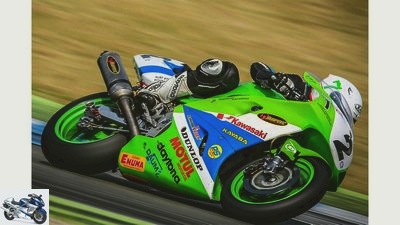
Rene Unger / Racepixx.de
11/21
After Schmid made it onto the podium in both races in 1995 in his wildcard competition in the Superbike World Championship, Seitz knew: You have to have a bike like this.

Rene Unger / Racepixx.de
12/21
It was only enough for Damsl for the predecessor, but today the dream is coming true. Because there he / she / it says: Paul! Not the youngest either, but a great and fascinating race iron.
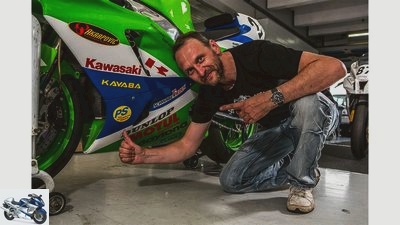
Rene Unger / Racepixx.de
13/21
Paul has hardly changed over the years, even the stickers are like they were back then.
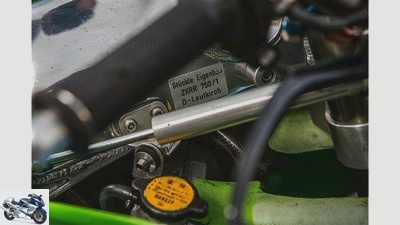
Rene Unger / Racepixx.de
14/21
Indeed, it’s Paul – the certificate of authenticity is emblazoned near the steering head.

Rene Unger / Racepixx.de
15/21
“The handling of the ZXR 750 RR is still convincing today, …
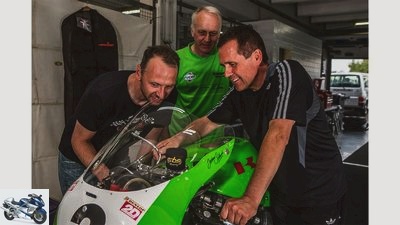
Rene Unger / Racepixx.de
16/21
… especially in comparison with the current 1000s. “
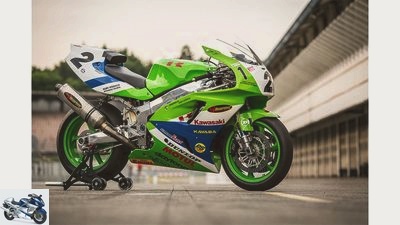
Rene Unger / Racepixx.de
17/21
Kawasaki ZXR 750 RR.
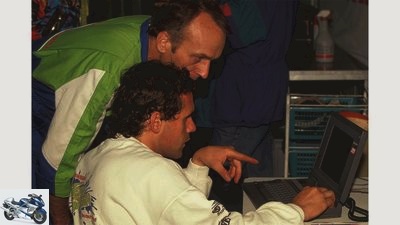
18/21
Kurt Stuckle (standing) and Jochen Schmid are absolutely meticulous analysts then and now. Through their perfect cooperation …
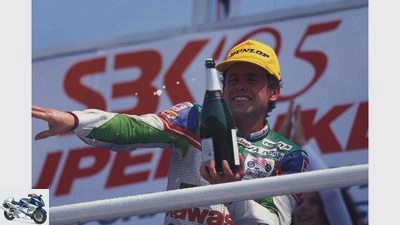
Stefan Wolf
19/21
… Many a bubbly bottle lost its cork.
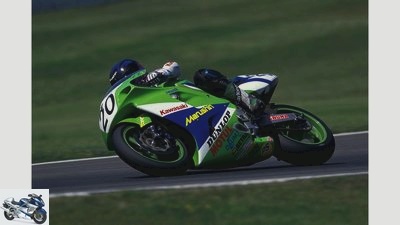
Stefan Wolf
20/21
“I could have gotten a better start, …

Stefan Wolf
21/21
… Fogarty wouldn’t have had a chance either, ”says Jochen Schmid.
Kawasaki ZXR 750 RR in the PS track test
Hero worship
Content of
After 20 years, the PS tester meets his dream bike from back then. Not just any old stove, but the Kawasaki grenade from World Cup hero Jochen Schmid. The Kawasaki ZXR 750 RR in the PS track test.
In the end, Paul was to blame for everything. In 1995 it had cost me a few sleepless nights and then a completely punctured semester break. Paul’s name is Jochen Schmids Kawasaki ZXR 750 RR. With her, the Backnang Pro Superbike hero taught Carl Fogarty and the rest of the Superbike World Championship elite fear at the World Championship run in May of that year. Schmid finally bagged a podium in both races when he played a wildcard, once third, once second – awesome!
Buy complete article
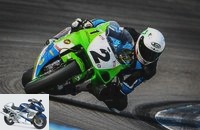
Kawasaki ZXR 750 RR in the PS track test
Hero worship
ZXR 750 RR – at least a piece of Paul – you have to have it! And months later, such a thing, albeit its predecessor with the famous “vacuum cleaner hoses”, was in front of the student dormitory. I never dared to dream of being able to drive the original myself once. But that’s exactly what should happen now. Exactly 20 years after Schmid’s hussar ride, right at the place of triumph – in Hockenheim.
What a huge motorcycle!
That morning I entered pits 23, very nervous. Finally, all the heroes of my stormy motorcycle years were gathered there: Jochen Schmid, the heroic racer, Kurt Stuckle, the legendary technician and finally – there he really was: Paul! Memories are awakened when circling. The race, the PS article on it, the moment when I was able to take my first ride through the Black Forest with my own Kawasaki ZXR 750 RR and unfortunately also how it was lying there weeks later on an embankment not far from Freiburg.
As if he had just come out of the box, Paul shines in the typical Kawa colors of the 1990s, this poison green, blue and brilliant white. Everything is like it was back then, even the old PS stickers are on. Only the starting number 20 at that time has become the triumphant 2 for the top placement. What a huge motorcycle, it flashes through my head, just this rear end! The rounds will probably be sobering, giving way to the highly emotional transfiguration of the harsh reality, in which 20 years of motorcycle development have tremendously shifted the standards.
Rene Unger / Racepixx.de
Kawasaki ZXR 750 RR.
Kurt Stuckle and Eberhard Wurst, who already worked for Jochen Schmid in the 250cc GP, have long since pulled the electric blankets over Paul’s fresh slicks and prepared everything meticulously. But there is still time until the right turn, so I can enjoy numerous racer stories and finally find out where Paul actually got his name from.
It was originally Schmid’s nickname from his youth, “and once in Brno he got off to a miserable start,” says Wurst. “One of them shouted: Paul screwed it up, and we then pushed it onto the motorcycle.” Jochen Schmid has a different version, because this one machine has always been his favorite. “Although we had two completely identical Kawas,” he continues. “So that everyone on the team knew which motorcycle I was talking about, we wrote Paul on the tank.”
Material at its best
Of course, I want to know why he ironed the world’s elite like that back then. “You’ll notice that immediately after you’ve done a few laps,” Schmid is certain. “The motorcycle is more manageable than current superbikes, and Kurt had prepared Paul perfectly from the engine to the chassis.” In fact, the Kawasaki ZXR 750 RR is emblazoned with the finest materials. This includes, for example, a Kayaba GP fork, which was actually only available in the GP 500 factory Suzuki. This was done through relationships with the Japanese Kayaba boss at the time in Germany. This meant that the Schmid / Stuckle team was even faster than the Kawasaki works team on golden chassis in joint tests in the following season. “Kawasaki team boss Harald Eckl didn’t invite us to the tests afterwards,” laughs Stuckle.
Another piece of cake is the airbox converted by Stuckle. The tank has been shortened for more volume and the filler neck has been relocated. 17 became 15 liters of fuel. This created space to inflate the airbox almost to the size of the trunk, in which the four Keihin flat slide racing carburetors suck in air for a whopping 160 hp on the bike.
Amazingly close to a current RSV4
The PVM brake with the six-piston calipers, which hold milled aluminum brackets over the 330 mm washers, is also unusual. “Today’s radial pliers are, of course, a bit crisper,” says Schmid of the brake system, “but with the large disks they grip quite well.” For Kurt Stuckle, the big secret lies in Paul’s geometry. “It’s astonishingly close to a current RSV4,” says the native of Allgau. “They weren’t stupid at Kawasaki back then and really accelerated their bikes, packed everything they had on it. You can see that in the chassis of the Kawasaki ZXR 750 RR. “
Then things get serious. Just a few more minutes. Jochen Schmid and Kurt Stuckle go through the motorcycle with me again. Paul has racing gear, so first gear up. Then Schmid pulls out a piece of paper on which he has noted the courses. I look at him in amazement: north curve, right towards Parabolika, hairpin, Mercedes curve and Sachskurve all in first gear – is that supposed to be a joke? “That translates to a long translation, but it fits exactly like that,” Schmid reassures me, and Stuckle immediately adds: “Between 10,000 and 14,000 revolutions – that’s where things go.” Back then in the World Championship race, first gear was even longer. “That’s why I had my problems at the start, but the Kawasaki ZXR 750 RR was very tightly spaced between second and sixth and, once it was in full swing, was able to put the others on their feet accordingly.”
Enough with the theory, the pit light turns green
Then the time has come. Since Paul doesn’t have a starter for minimal weight, Stuckle pushes me. And I screw it up! Paul doesn’t want to jump under me. While Stuckle is sweating from pushing on this hot May day, I’m sweating with embarrassment. Just before the pit lights, the four-cylinder finally howls. Of course I get a reprimand from the technician for my lack of feeling for Paul’s emotional life after the turn.
As soon as I am on the line, I cock the tap and flood the carburettors, which is surprisingly easy. It’s much more difficult with Schmid’s RC 30, which he also brought with him. When the 10,000 rpm mark was reached, Paul tears off as he had predicted and turned so greedily towards 14,000 revs that I quickly pushed into the next gear. Of course, Paul doesn’t have an automatic switch for that. Back then, you turned the throttle a little at lightning speed, took the tension off the drive and gave the gear lever a little pressure with the tip of your foot. This is how Jochen Schmid explained it to me before and Paul lets himself be fluffy. However, such shifting maneuvers require us electronics-used wannabes to coordinate the throttle hand and shift foot like that of a world-class drummer. Because if the process is not 100 percent correct, if you want too much too fast, Paul is a real refuser.
The Kawasaki ZXR 750 RR is super stable on the brakes
So I don’t make it once in my laps, from first gear to the right to parabolic, as Schmid has painted it, to shift into third when actually entering the parabolic. Accordingly, it always carries me far too far with my dogged switching shop. Despite this shortcoming, Paul can keep up with the current 1000s for a surprisingly long time. The speed must of course not fall below 9500 rpm, because then it crackles in the engine, Paul is simply not sprayed appropriately for the hot weather. Another problem that nobody has to deal with today.
At the end of the parabolic, Paul then plays out one of his great strengths. The Kawasaki ZXR 750 RR is super stable on the brakes. Nothing wobbles, and even when the clutch is relentlessly released into first gear, it keeps the line clean. No trace of fronds or pistils. And then the hairpin itself: crazy how Paul wants to go around there.
20 years? You don’t notice that in Paul
The feeling is best with less hanging-off than much more pushed in. And then Paul pulls again, lifts the front wheel slightly and then sizzles towards the quick right bend, which can be hit as cleanly with the Kawasaki ZXR 750 RR as with a perfectly tuned 600cc. No effort required, just aim, gently pull the handlebars and go around. You can also admire Paul’s cornering stability. Big cinema then follows in the Motodrom, because from the turn to the last corner on the home straight, Paul finally hangs out the show-off. In my favorite piece in Hockenheim, he rubs the class of the Kayaba fork under my nose so much that you really have the feeling of holding the front wheel in your hands. Since it glides through the double right to start / finish like a creamy cream – wonderful!
A crazy ride. 20 years? You just don’t notice that in Paul. Somehow it reminds me of a posh-made current R6. Well, you sit much more compact on one of these and are much more active. But she’s also much more nervous on the brakes. But when it comes to speed greed and handling, Paul is damn close, and thanks to the increased displacement, he still pushes much more decisively today. After the two turns that I was allowed to ride my original hero, the knowledge burned itself down: they knew damn well how a winning bike had to work. And Jochen Schmid then impressively demonstrated how you can be fast without an automatic switch and all electronic stuff. After me, the Schwabenpfeil easily shot a time of 1.47 minutes on the big course! Humble and yet happy, I left, because none of my heroes had disappointed me – I had done everything right back then.
Further information on the Schmid / Stuckle dream team
Kurt Stuckle (standing) and Jochen Schmid are absolutely meticulous analysts then and now.
After Jochen Schmid left the 250cc Grand Prix in 1993 after six years as a private rider, he actually expected a year without a race because he only wanted to ride for one of the official importer teams in the Pro Superbike. But they were all full. So did the Kawasaki team, which competed with Australian Rob Phillis and Michael Liedl. But when Liedl was canceled for the 1994 season, Jochen Schmid got his chance and met Kurt Stuckle. At the time, he had already been on the team as a technician for three years and was preparing the machines in Leutkirch, where he worked as a mechanic at the Honda dealer Kraft. But Schmid’s and Stuckle’s first year together in the German championship only got off to a difficult start. In the first race in Speyer Schmid was even lapped. In the middle of the season, however, the first victory came in Salzburg, and the following year the Kawasaki ZXR 750 RR with the two southern German protagonists was the champion motorcycle. In the same year, the duo then started with a wildcard in the Superbike World Championship in Hockenheim and made the big exclamation mark. Schmid still competed in World Championship races until 1999. Today he runs the family-owned bus company in his hometown of Backnang near Stuttgart (www.schmid-busreisen.de).
Kurt Stuckle, who has also looked after Max Neukirchner in the Superbike World Championship and from Stefan Nebel to Damian Cudlin in the IDM, runs a tuning forge under his name in Leutkirch (www.kurt-stueckle.de). He is currently taking care of the IDM Superbike and Superstock Bike from Luca Grunwald and Max Fritzsch – Kawasakis of course.
Related articles
-
triumph Track test: racing triumph Triumph as a racing version Whether in the Supersport World Championship or in cup races – the British three-cylinder…
-
Comparison test BMW S 1000 RR, Kawasaki ZX-10R and Yamaha YZF-R1M
22 images 1/22 BMW S 1000 RR, Kawasaki Ninja ZX-10R and Yamaha YZF-R1M. 2/22 Yamaha YZF-R1M. 3/22 BMW …
-
Kawasaki Premiere: Kawasaki ZX-6R The Kawasaki 636 Ninja Content of Traction control, two power modes, ABS – the 600s have arrived in the world of…
-
Kawasaki Z 650 in the test (2018)
17th photos 1/17 The Z 650 is very popular. This is no coincidence, but the result of an accurate…
-
Comparison test cruiser: Honda Shadow 750 and Kawasaki VN 900
fact comparison test: Cruiser, Honda Shadow 750, Kawasaki VN 900 Classic Honda Shadow 750 versus Kawasaki VN 900 For relatively little money, Kawasaki and …
-
Comparison test sports tourer Kawasaki Z 1000 SX Tourer, Triumph Sprint GT
www. 35 pictures www. 1/35 Sports tourers sit between all chairs, but the temptation lies in this niche: there are bikes, …
-
Ducati Multistrada 1200, Kawasaki Versys 1000 and Triumph Tiger 1050 in the test
Gargolov Funbikes in comparison test Ducati Multistrada 1200, Kawasaki Versys 1000 and Triumph Tiger 1050 With bag and pack on a big tour or simply …
-
MOTORCYCLE Supersport Test 2011: Race Track
jkuenstle.de 82 pictures Kuenstle 1/82 Easy to use traction control of the Aprilia. Kuenstle 2/82 A thoroughbred racing file with incredible …
-
Comparison test Harley-Davidson Fat Boy, Kawasaki 1500 VN, Yamaha XVZ 1300 A
Comparison test, Harley-Davidson Fat Boy, Kawasaki VN 1500 Classic, Yamaha XVZ 1300 A Royal Star Harley-Davidson Fat Boy, Kawasaki 1500 VN, Yamaha XVZ …
-
Kawasaki Ninja H2 in the top test
Bilski 26th photos Bilski 1/26 With 218 hp, the H2 is the most powerful bike on the MOTORRAD test bench to date. Bilski 2/26 The polished stainless steel…